Under the Bridge
In which s/v Impossible brings a little Windows to Appleville
Around one o’clock in the morning the whirring of the prop shaft reverberating through my bed coaxed me awake. I tried to ignore it by burying my head under more throw pillows, but it was everywhere. Sheena keeps too many throw pillows on our bed, and most days I hate them. Throw-away pillows, I call them. Lately I had come to appreciate the sound-muffling cocoon that I could form with them, but they were no match for the prop shaft this time. We must’ve been flying. After trying to talk myself out of it I finally got up to put a pipe wrench on the prop shaft, a hack job I’ve been using since the shaft brake stopped working earlier in the trip. I had put the engine key on a string and tied it to the wrench so that the engine couldn’t accidentally be started while the wrench was in place.
I stumbled into the pilothouse in my underwear, eyes on the pipe wrench sitting on the dash above the helm. As I passed the open companionway hatch, I stopped and looked up. The mizzen sail was halfway down, bellowed out to one side and Chuck and Matt were hanging in the air trying in vain to wrangle it down the mast in the roaring wind.
“Hey, uh…do you guys need any help?” I said meekly, hoping that somehow the answer would be no. Chuck turned to look at me, his red headlamp casting a radioactive glow on my pale, undie-clad figure. He communicated matter-of-factly amid what seemed like a real serious situation.
“Yes, I think so. You probably know how to do this better than we do, it being your boat and all,” he half-yelled, feet still dangling as he twisted in midair, grasping a reefing line. “We tried dropping the sail going downwind, but it’s blowing 30 knots and I think that may have been a bad idea.”
I blinked several times and tried to focus my bleary eyes. “Right. I’ll suit up and be right there.”
I sprinted back to my room, donned my foulies, and was on deck in less than a minute. I felt myself fly up the companionway steps and into the air, stepping on a cockpit cushion on the way to get a handle on a reefing line.
“Want me to turn upwind?” Chuck yelled above the wind.
I observed the towering waves. Getting crossways in these seas with full sails up could be a catastrophe. But Chuck had more experience than all of us combined and had crewed on this very boat a decade earlier on a Mexico-to-Seattle delivery.
“Hit it!” I said. Chuck waited until a wave crest passed and then cranked the wheel to port. He had five or six seconds to swing about before the next wave would be on us and he timed it perfectly. As the mizzen sail became slack, Matt and I hauled it down and tied it to the boom with sail ties. Without skipping a beat, Chuck pivoted the hull around in another wave trough and we were back in action with only the mainsail.
I commended Chuck and Matt on a well-executed maneuver, popped into the engine room to secure the prop shaft, and then fell back into my cocoon of throw pillows in my skivvies, unexpectedly salt-sprayed, wind-whipped, and pumping with adrenaline.
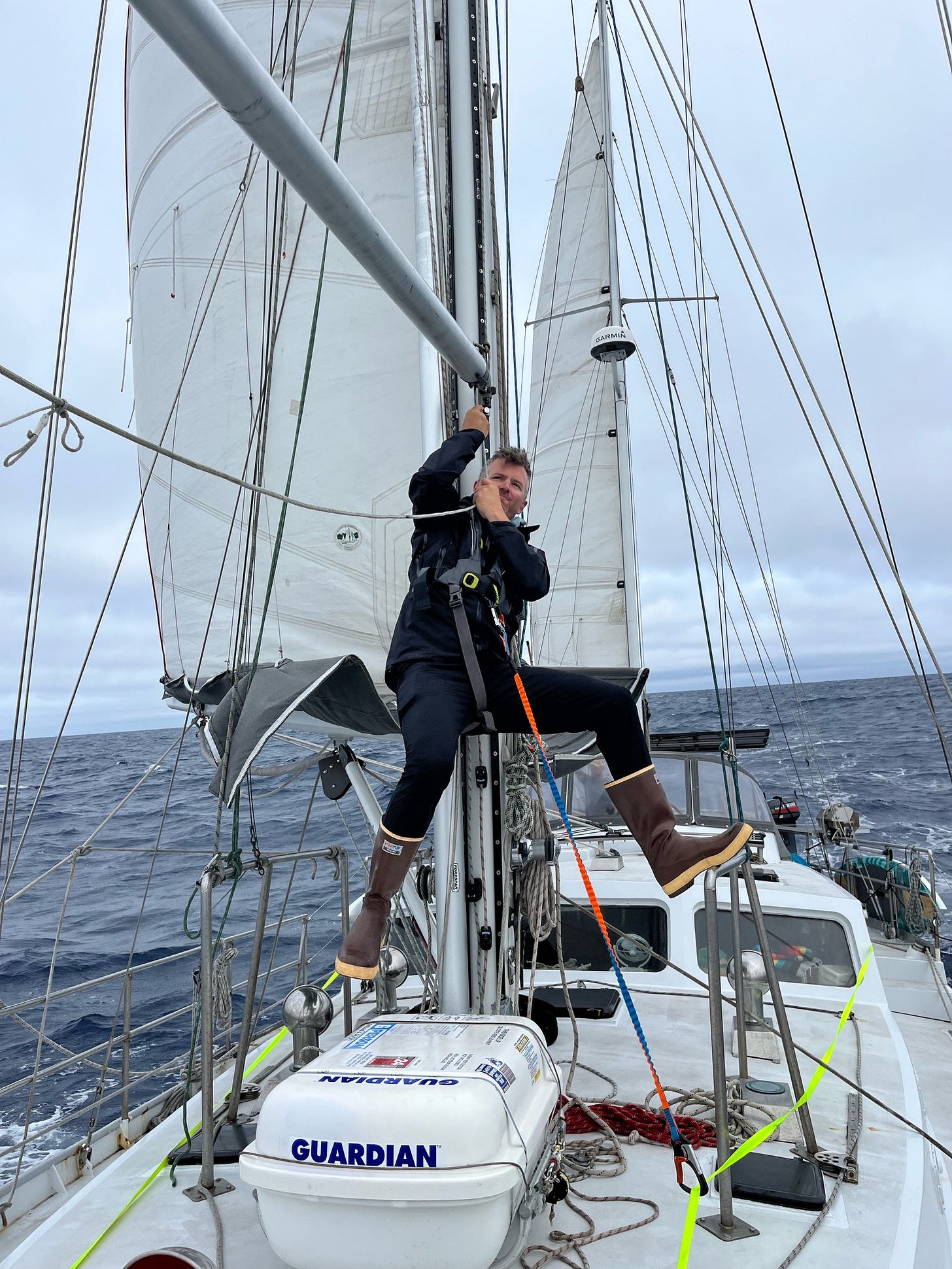
The West Coast is studded with small points of land jutting into the sea—capes, as they are known to the sailor people. Cape Disappointment, Cape Blanco, and so on. Cape Mendocino, the final cape before San Francisco, is the most menacing of the bunch. Often called the Cape Horn of the Pacific, the geography of Cape Mendocino greets sailors with whirling storms, high winds, heavy seas, and is considered the most formidable feature of the trip.
As Murphy and his law would dictate, we would pass Cape Mendocino in the middle of the night. After evacuating the adrenaline from my system and nabbing another hour of shut-eye following the mizzen/underpants incident, Noah and I were next up for the 3:00-6:00 AM watch and Cape Mendocino lay directly ahead.
My night watches with Noah had been a pleasure. Night shifts lasted three hours and there were two ways to go about it. One approach was to set a conservative sail plan before dark and wait for the time to pass, battling the urge to sleep and trying to find things to talk about. The other way—the more entertaining way—was to continue sailing through the night as if it were day, optimizing the sail plan as conditions changed. This often meant that we spent our shifts throwing reefs in (reducing the size of the sails in high winds), shaking reefs out (raising the full sails when wind speed decreased), and using different sail combinations and whisker pole configurations. A few sail changes could make a night shift fly by.
At around 3:30 in the morning a strobe light began flashing on and off somewhere nearby. We dove at the radar screen and searched our immediate surroundings for what must have been a giant container ship bearing down on us. But among the random blobs on the screen, none appeared to be ships bearing down.
It occurred to me that maybe someone had accidentally activated our own boat’s mast-top strobe light, but I confirmed the switch was off.
A few miles away we noticed a tanker on our AIS, a sort of GPS-driven ship tracking system that overlays ships’ positions on our electronic charts. Noah got on the radio and called the ship’s captain to ask if he was using a strobe light. The captain contemplated this seemingly idiotic question and reported that he was not. Meanwhile every few seconds the air, thick with water vapor, turned from pitch black to bright white, transforming our pupils repeatedly from pinholes to ink pots.
We sat there like two dolts, staring into the night trying to figure out where in the hell the strobe light was coming from. Were we about to crash into a lighthouse? No, we were 30 miles offshore. Not a ship. I changed the direction of my gaze with every strobe to try to pinpoint its direction, but it was coming from everywhere all at once.
Noah studied the chartplotter. Up ahead there were now several ominous red blobs, and what should have initially been obvious finally came to me as an epiphany.
“It’s lightning!”
We looked at each other, waited for the next one, and then laughed it off as if we hadn’t been utterly confounded by lightning like a couple of cave men.
We continued watching our little indicator on the radar screen move slowly closer and closer to the red blobs—thunderstorms—just off the tip of Cape Mendocino. As soon as it was just about too late, my next epiphany finally, at long last, came.
“Maybe we should try to steer around them.” We altered course but it was too late. We were headed right into the center. Within minutes the wind picked up. As we had been flying full sails, we agreed it would be wise to reef the main and genoa.
We furled the genoa to the second reef, reducing the sail area in half. Next, I clipped my harness into a safety line running the length of the boat and made my way to the base of the main mast with my headlamp illuminating the way. The wind had picked up from 15 to 25 knots and a blanket of salt spray repeatedly flew over the starboard rail, soaking me with each passing wave in the pitch black.
Surrounded by lightning, soaked by crashing waves, and holding onto the mast for dear life, my world was reduced to the small circle of activity illuminated by my headlamp. Release main halyard. First reefing line onto the winch. Call to Noah to sheet in the main to reduce the force on the sail. Winch down the first reef. Second reef onto the winch. Winch down the second reef. Can’t hear anything anymore. Boat wildly rocking. Wind screaming. This is living!
Despite what I would at one time have considered an uncomfortable situation, I was loving this. The exhilaration! I finally understood what Lieutenant Dan was on about when he was perched up there on the spreader of his shrimping boat in that storm.
I clambered back to Noah in the cockpit, shit-eating grin plastered across my face. He was clearly enjoying this just as much as I was, but he cut short my whoops and yips with a suggestion.
“Do you think we should just drop the sail altogether?” He yelled above the chaos of the wind.
“Huh? I just double-reefed!”
“Yeah, I know! I think we should drop the sail now!”
“Why!?”
“Because while you were up there the wind picked up to 40 and it’s still climbing!”
Reefing downwind in 30 knots was about all the sail could take without ripping it, so this time Noah whipped the boat around 180-degrees to put the bow into the wind and I returned to the mast to drop and tie up the sail. We furled the genoa and put out the much smaller staysail, and then resumed our course under mizzen and staysail. We handed over the helm to the next watch just as the sun started to cast its glow in the eastern sky. Cape Mendocino, and the most exhilarating watch of the trip, were behind us.
A full day later, after rounding Point Reyes, we finally laid eyes on the main prize: the Golden Gate Bridge. Cheers erupted all around the boat and the crew gathered on deck to take in the sight.
Back in 1996, as a farewell gift for this boat’s first trans-Pacific voyage, Bill Gates had a custom spinnaker commissioned for Impossible by Carol Hasse, an iconic sailmaker in Port Townsend. The spinnaker was emblazoned with the symbol of Seattle’s big leap forward in tech: a Windows 95 logo as big as a school bus. Each window in the logo was hand cut and stitched into a giant parachute that could be deployed off the bow of the boat when sailing downwind. As we sailed under the Golden Gate and into the Land of Apple, we hoisted what is most certainly the world’s largest Windows 95 logo to announce that Seattle had arrived. Right-click, bitches!
After passing under the bridge beating our chests and gloating with our Seattle pride, we set out to douse the spinnaker so that we could prepare to anchor in front of Tiburon and enjoy some celebratory tacos and sangria. In a near-perfectly executed symphony of coordination (emphasis on near), we deployed the genoa to block the wind from the spinnaker, then two of us grabbed the spinnaker sheets and began to pull it down. Next, I yelled to Matt to release the spinnaker halyard so we could pull it onto the deck, and that is when our hubris caught up to us.
“Is it the one that’s labeled Genoa 2?” He yelled.
“Just do it!” I said, not really considering his question.
“Here goes!” He said, and then the entire genoa fell out of the sky and slid under the boat while we continued yanking in vain on the spinnaker. The spinnaker suddenly re-filled, re-emphasizing our Seattle pride.
A casual observer on the Golden Gate would have watched our last act of sailing these 1,000 miles as the entire crew slowly “shrimped” the genoa out of the ocean, inch by startlingly heavy inch, over the port railing and back onto the deck.


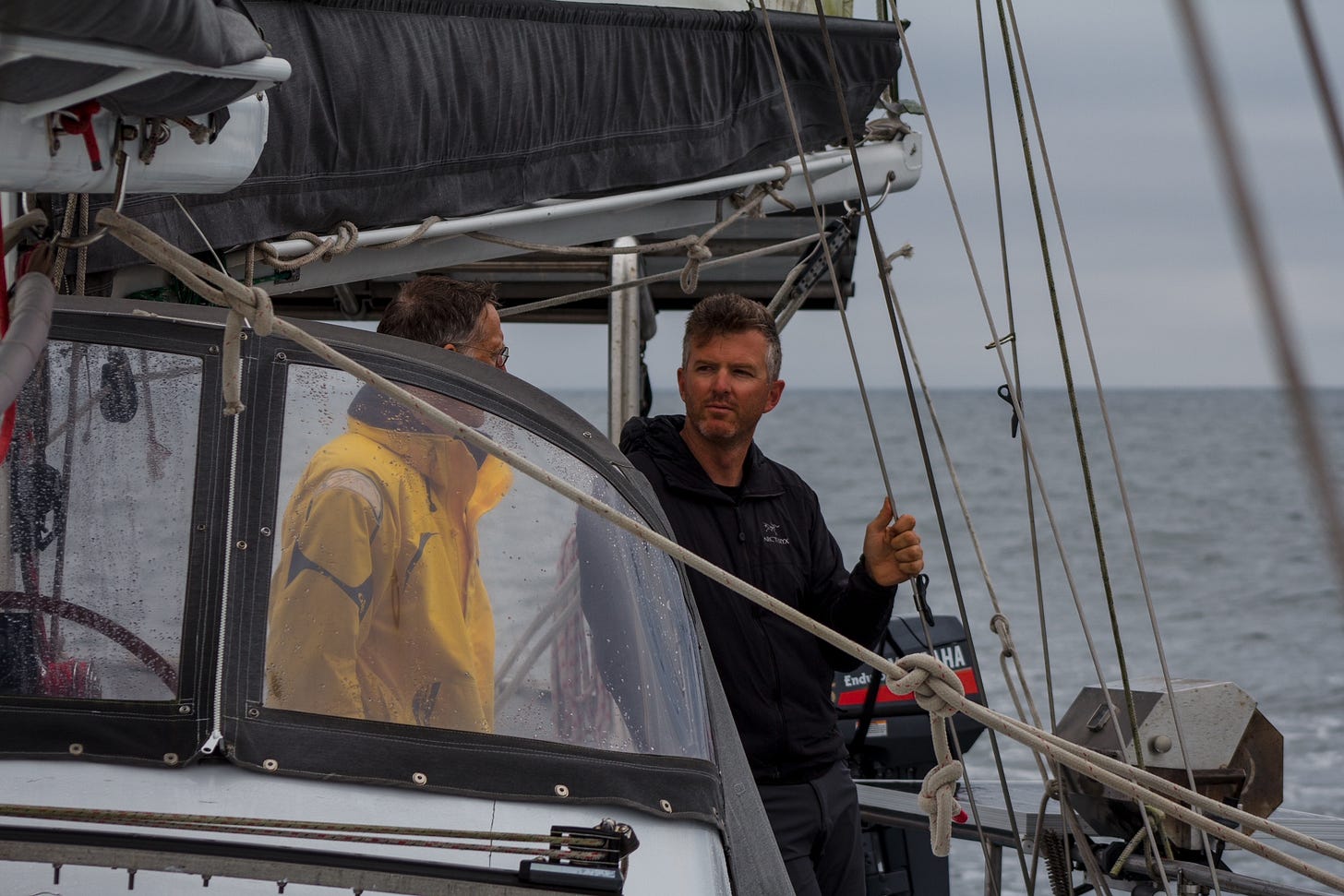
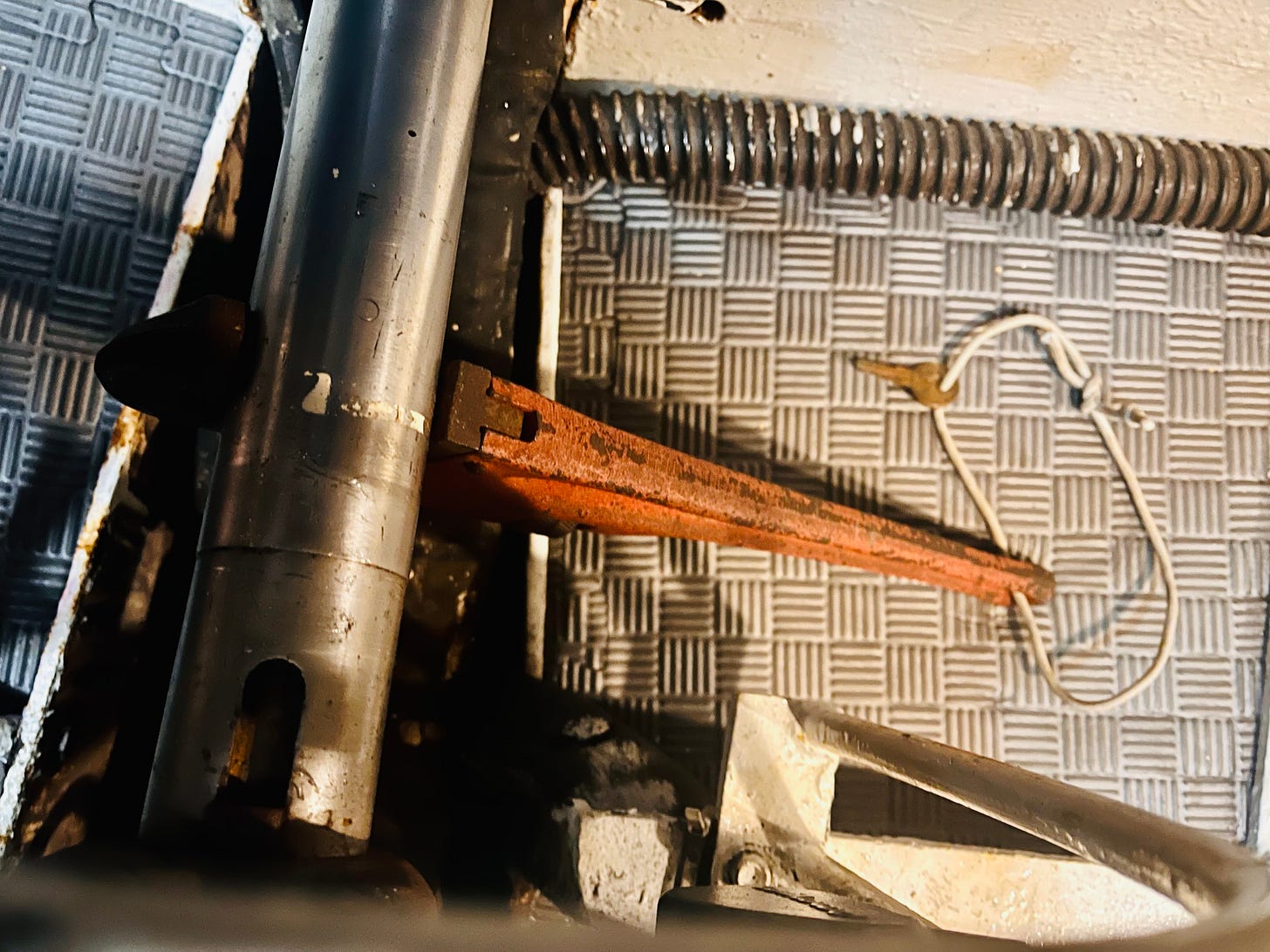

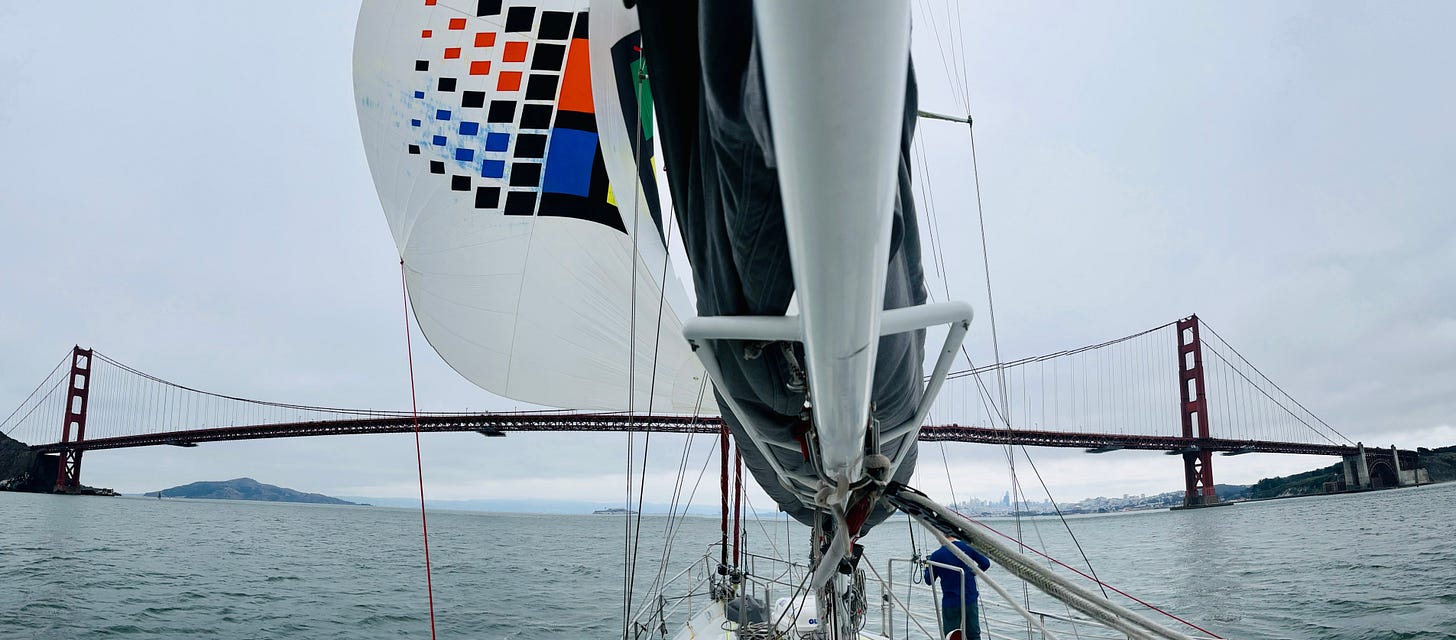
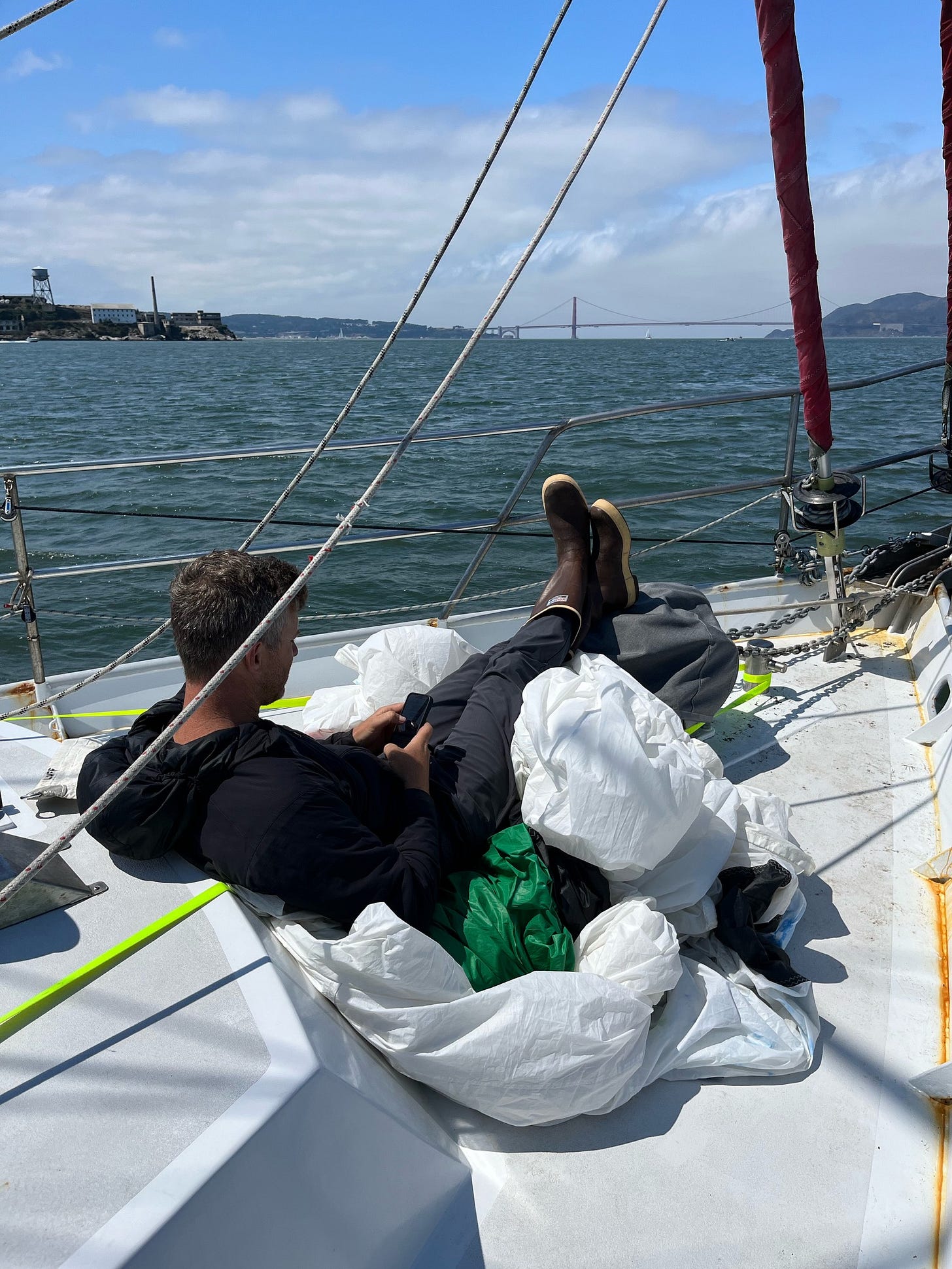

As your mom, I am glad I am hearing about the harrowing parts of this voyage AFTER the fact! It is no surprise to me that those events were the highlights of your voyage to San Francisco. Living on the edge is in your blood. You go, son!